



China on Feb. 25 held a grand gathering at the Great Hall of the People in Beijing to mark the country’s accomplishments in poverty eradication and commend role models in that cause. The rural electricity department of the State Grid Tibet Electric Power Company was rewarded for its outstanding contribution to the poverty alleviation fight.
Since 2016, the State Grid Tibet Electric Power Company has invested a total of 49.4 billion yuan ($7.64 billion) in power grid construction in southwest China’s Tibet Autonomous Region, where over 100,000 constructors overcame harsh conditions and completed the construction of four major grid projects – the Qinghai-Tibet power grid interconnection, Sichuan-Tibet power grid interconnection, central region of Tibet power grid interconnection project and Ngari power grid interconnection. The efforts have connected Tibetan households to safe electricity and offered strong support for the autonomous region to shake off poverty.
Local workers in Tibet were employed more than 1.47 million times in total in the construction of power grid projects, which helped them increase income by nearly 1.32 billion yuan. The company expanded the income for the group by 293 million yuan in 2020 alone.
At the end of the last year, the Ngari power grid interconnection, a project with an investment of 7.4 billion yuan, was put into service, connecting Ngari Prefecture to the country’s state grid. By then, all 74 counties and prefectures of the autonomous region had been connected to the state grid, which largely boosted the livelihood improvement and development of nearly 380,000 farmers and herdsmen in 16 counties along the project.
As the final region connected to the state grid in Tibet Autonomous Region, Ngari used to be trapped by power shortage, which limited the development of the prefecture that boasts rich tourism and industrial resources.
The director of the rural electricity department of the State Grid Tibet Electric Power Company He Longshou introduced that he was once reminded by the front desk of a hotel in Ngari to charge his devices during the daytime, as the power would go off at night, during a business trip to the prefecture.
“The frequent blackouts not only led to high operation cost of hotels, but also prevented them from expanding their business,” said Dawa Putri, manager of a hotel in Saga County, Shigatse.
As an important transit along the National Highway 219, Saga enjoys prospering tourism, and there are many hotels in the township. However, all the hotels must prepare backup generators in the county that relied solely on hydropower. As a result, they had to suffer not only unstable voltage, but also a fuel cost that might run up to one or two thousand yuan per day.
As the Ngari power grid interconnection project came into service, power supply is no longer a problem, and the cost of hotels dropped drastically. Many owners of hotels in the county are now planning to expand their business.
In a factory that processes tsampa, a Tibetan staple foodstuff made from roasted barley flour in Rutog village, Ngari, all production procedures are now powered by electricity, including cleaning, frying, grinding and packaging.
“Being connected to the state grid, our factory now has more stable production and a lower cost,” said Phuntsog Tsering, head of the factory.
At present, over 30 local people with physical disabilities and from impoverished households are working for tsampa, Tibetan incense and wool processing factories in the village.


The Humanitarian Service Diamond Awards has.
A Chinese Company, Inner Galaxy Steel.


The Programme Coordinator, Regulatory, Compliance and.


A Non-Governmental Organization (NGO), Committee for.
The Trustfund Pensions Limited has chided.


The House of Representatives Committee on.
The China General Chamber of Commerce.


Senator Chuka Utazi who represented Enugu.


An Abuja based Legal Practitioner, Ugochukwu.


The African business community in Yiwu,.
Leave a Comment